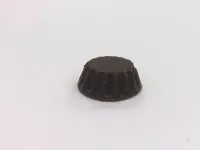(Press-News.org) February 12, 2024, Mountain View, CA -- In a paper published in the Astronomical Journal, a team of researchers from the SETI Institute, Berkeley SETI Research Center and the University of Washington reported an exciting development for the field of astrophysics and the search for extraterrestrial intelligence (SETI), using observations from the Transiting Exoplanet Survey Satellite (TESS) mission to monitor the SETI Ellipsoid, a method for identifying potential signals from advanced civilizations in the cosmos. The SETI Ellipsoid is a strategic approach for selecting potential technosignature candidates based on the hypothesis that extraterrestrial civilizations, upon observing significant galactic events such as supernova 1987A, might use these occurrences as a focal point to emit synchronized signals to announce their presence.
In this work, researchers show that the SETI Ellipsoid method can leverage continuous, wide-field sky surveys, significantly enhancing our ability to detect these potential signals. By compensating for the uncertainties in the estimated time-of-arrival of such signals using observations that span up to a year, the team implements the SETI Ellipsoid strategy in an innovative way using state-of-the-arc technology.
“New surveys of the sky provide groundbreaking opportunities to search for technosignatures coordinated with supernovae.” said co-author Bárbara Cabrales. “The typical timing uncertainties involved are of a couple months, so we want to cover our bases by finding targets that are well-documented over the course of about a year. In addition to that, it’s important to have as many observations as possible for each target of interest, so that we can determine what looks like normal behavior and what might look like a potential technosignature.”
In examining data from the TESS continuous viewing zone, covering 5% of all TESS data from the first three years of its mission, researchers utilized the advanced 3D location data from Gaia Early Data Release 3. This analysis identified 32 prime targets within the SETI Ellipsoid in the southern TESS continuous viewing zone, all with uncertainties refined to better than 0.5 light-years. While the initial examination of TESS light curves during the Ellipsoid crossing event revealed no anomalies, the groundwork laid by this initiative paves the way for expanding the search to other surveys, a broader array of targets, and exploring diverse potential signal types.
Applying the SETI Ellipsoid technique to scrutinize large archival databases signifies a monumental step forward in the search for technosignatures. Utilizing Gaia's highly precise distance estimates, the study demonstrates the feasibility of cross-matching these distances with other time-domain surveys like TESS to enhance monitoring and anomaly detection capabilities in SETI research.
The SETI Ellipsoid method, combined with Gaia's distance measurements, offers a robust and adaptable framework for future SETI searches. Researchers can retrospectively apply it to sift through archival data for potential signals, proactively select targets, and schedule future monitoring campaigns.
“As Dr. Jill Tarter often points out, SETI searches are like looking for a needle in a 9-D haystack,” said co-author Dr. Sofia Sheikh. “Any technique that can help us prioritize where to look, such as the SETI Ellipsoid, could potentially give us a shortcut to the most promising parts of the haystack. This work is the first step in searching those newly-highlighted parts of parameter space, and is an exciting precedent for upcoming large survey projects like LSST.”
As humanity continues to explore the mysteries of the universe, the SETI Institute remains at the forefront, employing innovative techniques like the SETI Ellipsoid to bridge cosmic distances and connect with potential civilizations among the stars.
Paper: https://doi.org/10.3847/1538-3881/ad2064 .
About the SETI Institute
Founded in 1984, the SETI Institute is a non-profit, multi-disciplinary research and education organization whose mission is to lead humanity’s quest to understand the origins and prevalence of life and intelligence in the Universe and to share that knowledge with the world. Our research encompasses the physical and biological sciences and leverages expertise in data analytics, machine learning and advanced signal detection technologies. The SETI Institute is a distinguished research partner for industry, academia and government agencies, including NASA and NSF.
Contact information
Rebecca McDonald
Director of Communications
SETI Institute
rmcdonald@seti.org
END
SETI institute employs SETI ellipsoid technique for searching for signals from distant civilizations
Researchers show that the SETI Ellipsoid method can leverage continuous, wide-field sky surveys, significantly enhancing our ability to detect these potential signals
2024-02-12
ELSE PRESS RELEASES FROM THIS DATE:
Sugar-reduced chocolate with oat flour just as tasty as original, study finds
2024-02-12
UNIVERSITY PARK, Pa. — The secret to making delicious chocolate with less added sugar is oat flour, according to a new study by Penn State researchers. In a blind taste test, recently published in the Journal of Food Science, 25% reduced-sugar chocolates made with oat flour were rated equally, and in some cases preferred, to regular chocolate. The findings provide a new option for decreasing chocolate’s sugar content while maintaining its texture and flavor.
“We were able to show that there is a range in which you can ...
AI-supported image analysis: metrics determine quality
2024-02-12
How well do the algorithms used in the AI-supported analysis of medical images perform their respective tasks? This depends to a large extent on the metrics used to evaluate their performance. An international consortium led by scientists from the German Cancer Research Center (DKFZ) and the National Center for Tumor Diseases (NCT) in Heidelberg has compiled the knowledge available worldwide on the specific strengths, weaknesses and limitations of the various validation metrics. With "Metrics Reloaded", the researchers are ...
Innovative decarbonization: UH researcher offers carbon-driven framework to accelerate shift toward net-zero electric power sector
2024-02-12
Houston, Texas, the epicenter of the global energy market, and the University of Houston – the Energy University – are leading the transition towards a cleaner, more sustainable future with innovative solutions.
With three-quarters of U.S. greenhouse gas emissions stemming from burning fossil fuels for energy, it's clear that the key to curbing emissions lies in reimagining how energy is produced and consumed. In Texas, the shift is already well on its way. Technologies like giant batteries, ...
White people more likely to confront authors of racist online posts to set discussion rules
2024-02-12
CHAMPAIGN, Ill. — White people surveyed in a recent study indicated they would be more likely to confront those who post racist content on social media if their objective were to defend the norms for political discussions rather than to change the person’s prejudiced beliefs.
Communication professors Stewart M. Coles of the University of Illinois Urbana-Champaign and Daniel S. Lane of the University of California, Santa Barbara surveyed people during the 2020 U.S. presidential election cycle to explore the conditions under ...
University of Rhode Island Nutrition study to help inform official USDA dietary guidelines
2024-02-12
Ultra-processed foods make up more than half the food average Americans eat. Including frozen and prepared meals, most packaged snacks, desserts and carbonated soft drinks—but also including more innocuous foods—they are often considered the bane of healthy eating, containing little to no nutrition to fuel healthy bodies.
However, “not all processed foods are created equal,” according to University of Rhode Island Nutrition Professor Kathleen Melanson. Evidence to support the assumption that ultra-processed foods are all bad for one’s health is limited, and the nutritional ...
Number of at-risk youth with intellectual disability and autism in the U.S. foster care system is growing
2024-02-12
Youth with foster care involvement have an increased risk for mental health diagnoses, trauma and worse outcomes in adulthood than their peers. Research about how youth with disabilities, including autism and intellectual disability, interact with this system is lacking. Evidence for how youth with autism or intellectual disability in the foster care system access and use services is needed to advance ways to improve their outcomes.
Recently published in the Journal of the American Medical Association (JAMA) Pediatrics, researchers at Drexel University’s A.J. Drexel Autism Institute, in collaboration with George Mason University’s ...
Multiple city hubs, dispersed parks keep metro areas cooler
2024-02-12
ITHACA, N.Y. – Metropolitan areas with multiple city centers and dispersed green spaces mitigate extreme heat more effectively than those with one dominant city, an analysis by Cornell University city planning scholars finds.
Compared to “monocentric” development, “polycentric” spatial patterns better distribute the density of urban cores and curb the sprawl of impervious, heat-absorbing surfaces, according to the analysis of 50 city regions in Germany. Particularly in larger urban areas, polycentric development can moderate the urban heat island effect, ...
Innovation to overcome deficiencies in 3D printing
2024-02-12
The University of Houston is collaborating with Texas A&M University to tackle the challenge hindering the use of Additive Manufacturing (AM), commonly known as 3D printing, for a variety of commercial applications – the need for real-time monitoring and analysis to ensure consistent quality and reproducibility throughout the production process.
At present, quality control and qualification of metal AM parts is mostly carried out through offline inspection and characterization, but ideally, a broad range of sub-surface and bulk microstructural ...
Novel bispecific design improves CAR T–cell immunotherapy for childhood leukemia
2024-02-12
(MEMPHIS, Tenn. – February 12, 2024) St. Jude Children’s Research Hospital scientists improved chimeric antigen receptor (CAR) T–cell immunotherapy for acute myeloid leukemia (AML), demonstrating better efficacy in the lab. To overcome common problems with CAR T cells, the researchers created an additional means for the therapy to find and eliminate cancer cells, using a small peptide. The study also showed how a computational approach incorporating AlphaFold predicted protein models could help ...
Including socioeconomic status of patients in calculation of Medicare readmission penalties would reduce stress on safety-net hospitals
2024-02-12
INDIANAPOLIS -- The Affordable Care Act requires Medicare to issue penalties that reduce payment to hospitals if post-operative readmission rates within 30 days exceed the national average. A new study led by Regenstrief Institute Research Scientist Andrew Gonzalez, M.D., J.D., MPH, reports that including socioeconomic status in the penalty calculation would reduce the amount of readmission penalties for safety-net hospitals, which typically care for the sickest patients. Other factors, including age and sex are ...
LAST 30 PRESS RELEASES:
Injectable breast ‘implant’ offers alternative to traditional surgeries
Neuroscientists devise formulas to measure multilingualism
New prostate cancer trial seeks to reduce toxicity without sacrificing efficacy
Geometry shapes life
A CRISPR screen reveals many previously unrecognized genes required for brain development and a new neurodevelopmental disorder
Hot flush treatment has anti-breast cancer activity, study finds
Securing AI systems against growing cybersecurity threats
Longest observation of an active solar region
Why nail-biting, procrastination and other self-sabotaging behaviors are rooted in survival instincts
Regional variations in mechanical properties of porcine leptomeninges
Artificial empathy in therapy and healthcare: advancements in interpersonal interaction technologies
Why some brains switch gears more efficiently than others
UVA’s Jundong Li wins ICDM’S 2025 Tao Li Award for data mining, machine learning
UVA’s low-power, high-performance computer power player Mircea Stan earns National Academy of Inventors fellowship
Not playing by the rules: USU researcher explores filamentous algae dynamics in rivers
Do our body clocks influence our risk of dementia?
Anthropologists offer new evidence of bipedalism in long-debated fossil discovery
Safer receipt paper from wood
Dosage-sensitive genes suggest no whole-genome duplications in ancestral angiosperm
First ancient human herpesvirus genomes document their deep history with humans
Why Some Bacteria Survive Antibiotics and How to Stop Them - New study reveals that bacteria can survive antibiotic treatment through two fundamentally different “shutdown modes”
UCLA study links scar healing to dangerous placenta condition
CHANGE-seq-BE finds off-target changes in the genome from base editors
The Journal of Nuclear Medicine Ahead-of-Print Tip Sheet: January 2, 2026
Delayed or absent first dose of measles, mumps, and rubella vaccination
Trends in US preterm birth rates by household income and race and ethnicity
Study identifies potential biomarker linked to progression and brain inflammation in multiple sclerosis
Many mothers in Norway do not show up for postnatal check-ups
Researchers want to find out why quick clay is so unstable
Superradiant spins show teamwork at the quantum scale
[Press-News.org] SETI institute employs SETI ellipsoid technique for searching for signals from distant civilizationsResearchers show that the SETI Ellipsoid method can leverage continuous, wide-field sky surveys, significantly enhancing our ability to detect these potential signals








